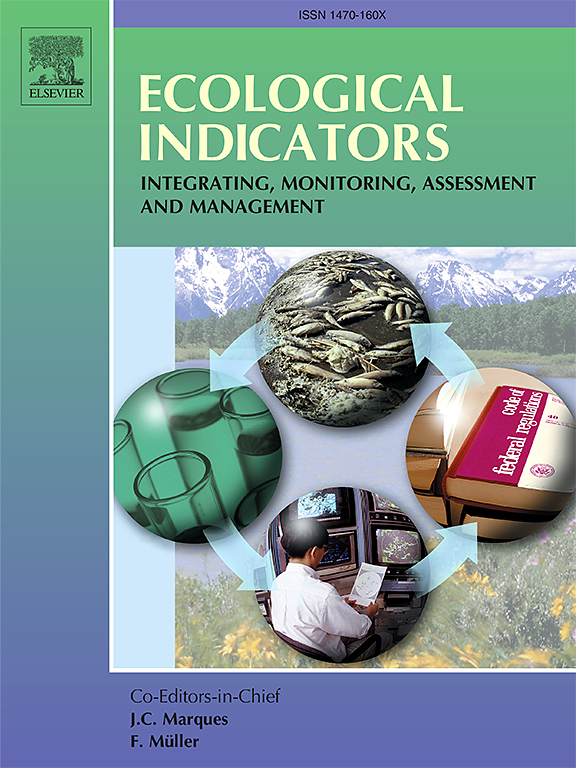卫星揭示了中国西南高原湖泊藻华的长期物候变化和环境驱动因素
IF 7
2区 环境科学与生态学
Q1 ENVIRONMENTAL SCIENCES
引用次数: 0
摘要
近年来,高原湖泊生态系统面临着显著的挑战,其特征是藻华(ABs)频率激增,从而对人类福祉和生态系统的完整性构成重大威胁。在现有的基于卫星的抗菌素监测中,对抗菌素物候的系统分析还很缺乏。本文以滇池、洱海、星云、齐鲁、澄海5个具有代表性的高原湖泊为研究对象,利用1987 - 2023年高空间分辨率Landsat和Sentinel-2卫星数据,利用浮藻指数(FAI)和阈值分割方法,获得了这些湖泊AB区长期序列和物候特征。结果表明,除滇池外,其他湖泊的月平均水华面积百分比呈显著上升趋势。特别值得注意的是,在星云湖观测到的大量增加(斜率= 0.94,p <;0.01)和齐鲁(斜率= 0.46,p <;0.01)。此外,从1987年到2023年,这些湖泊的年ABs频率呈现先增加后下降的趋势,其中夏季和秋季频率最高。相关分析表明,4年周期月平均水华面积百分比的大小主要与湖泊污染相关的水质参数有关(r = 0.35, p <;0.01)和富营养化(r = 0.34, p <;0.01)。相反,4年周期AB的频率与气象因子相关,包括春季平均气温(r = 0.35, p <;0.05)和冬季风速(r = 0.31, p <;0.05)。此外,ABs的终止时间受冬季平均降水量的影响(r = 0.3, p <;0.05)和4年循环地表水温度(r = 0.36, p <;0.05)。本研究阐明了高原湖泊ABs的持续物候模式,并探讨了多种环境因素驱动的潜在机制。这些发现将加强对抗体演变和减缓的理解,从而促进在更复杂的气候变化和人为影响背景下对抗体的预测和控制。本文章由计算机程序翻译,如有差异,请以英文原文为准。
Satellites unveil long-term phenological shifts and environmental drivers of algal blooms in plateau lakes of southwestern China
In recent years, the ecosystems of plateau lakes have encountered notable challenges characterized by a surge in the frequency of algal blooms (ABs), thereby presenting a substantial threat to both human well-being and ecosystem integrity. While the existing satellite-based monitoring of ABs, there still remains a scarcity of systematic analysis of AB phenology. This study focuses on five representative plateau lakes in Yunnan Province, China, namely Dianchi, Erhai, Xingyun, Qilu, and Chenghai, all of which have encountered occurrences of ABs. By integrating high-spatial-resolution Landsat and Sentinel-2 satellite data from 1987 to 2023, we derived the long-term sequences and phenological patterns of AB areas in these lakes using the Floating Algae Index (FAI) and the threshold segmentation method. The findings demonstrated a notable upward trend in the monthly average percentage of bloom areas across these studied lakes, except for Lake Dianchi. Particularly noteworthy were the substantial increases observed in Lake Xingyun (slope = 0.94, p < 0.01) and Qilu (slope = 0.46, p < 0.01). Additionally, the annual frequency of ABs across these lakes demonstrated an initial increase followed by a subsequent decline from 1987 to 2023, with the highest frequency observed during the summer and autumn months. Correlation analysis revealed that the magnitude of the four-year cycle monthly average percentage of bloom area was primarily linked to water quality parameters related to lake pollution (r = 0.35, p < 0.01) and eutrophication (r = 0.34, p < 0.01). Conversely, the frequency of AB on a four-year cycle correlated with meteorological factors, including mean spring air temperature (r = 0.35, p < 0.05) and winter wind speed (r = 0.31, p < 0.05). Furthermore, the termination time of ABs was influenced by mean winter precipitation (r = 0.3, p < 0.05) and four-year cycle surface water temperature (r = 0.36, p < 0.05). This study elucidated the persistent phenological patterns of ABs in plateau lakes and explored the underlying mechanisms driven by multiple environmental factors. These findings would enhance comprehension regarding the evolution and mitigation of ABs, thereby facilitating the prediction and control of ABs in the context of more complex climate changes and anthropogenic impacts.
求助全文
通过发布文献求助,成功后即可免费获取论文全文。
去求助
来源期刊

Ecological Indicators
环境科学-环境科学
CiteScore
11.80
自引率
8.70%
发文量
1163
审稿时长
78 days
期刊介绍:
The ultimate aim of Ecological Indicators is to integrate the monitoring and assessment of ecological and environmental indicators with management practices. The journal provides a forum for the discussion of the applied scientific development and review of traditional indicator approaches as well as for theoretical, modelling and quantitative applications such as index development. Research into the following areas will be published.
• All aspects of ecological and environmental indicators and indices.
• New indicators, and new approaches and methods for indicator development, testing and use.
• Development and modelling of indices, e.g. application of indicator suites across multiple scales and resources.
• Analysis and research of resource, system- and scale-specific indicators.
• Methods for integration of social and other valuation metrics for the production of scientifically rigorous and politically-relevant assessments using indicator-based monitoring and assessment programs.
• How research indicators can be transformed into direct application for management purposes.
• Broader assessment objectives and methods, e.g. biodiversity, biological integrity, and sustainability, through the use of indicators.
• Resource-specific indicators such as landscape, agroecosystems, forests, wetlands, etc.
 求助内容:
求助内容: 应助结果提醒方式:
应助结果提醒方式:


